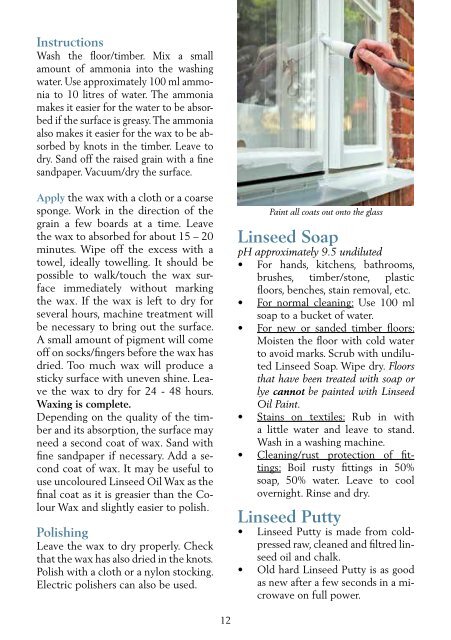ALLBÄCK WINDOWCRAFT & LINSEED OIL PAINT - Solvent Free ...
ALLBÄCK WINDOWCRAFT & LINSEED OIL PAINT - Solvent Free ...
ALLBÄCK WINDOWCRAFT & LINSEED OIL PAINT - Solvent Free ...
You also want an ePaper? Increase the reach of your titles
YUMPU automatically turns print PDFs into web optimized ePapers that Google loves.
Instructions<br />
Wash the floor/timber. Mix a small<br />
amount of ammonia into the washing<br />
water. Use approximately 100 ml ammonia<br />
to 10 litres of water. The ammonia<br />
makes it easier for the water to be absorbed<br />
if the surface is greasy. The ammonia<br />
also makes it easier for the wax to be absorbed<br />
by knots in the timber. Leave to<br />
dry. Sand off the raised grain with a fine<br />
sandpaper. Vacuum/dry the surface.<br />
Apply the wax with a cloth or a coarse<br />
sponge. Work in the direction of the<br />
grain a few boards at a time. Leave<br />
the wax to absorbed for about 15 – 20<br />
minutes. Wipe off the excess with a<br />
towel, ideally towelling. It should be<br />
possible to walk/touch the wax surface<br />
immediately without marking<br />
the wax. If the wax is left to dry for<br />
several hours, machine treatment will<br />
be necessary to bring out the surface.<br />
A small amount of pigment will come<br />
off on socks/fingers before the wax has<br />
dried. Too much wax will produce a<br />
sticky surface with uneven shine. Leave<br />
the wax to dry for 24 - 48 hours.<br />
Waxing is complete.<br />
Depending on the quality of the timber<br />
and its absorption, the surface may<br />
need a second coat of wax. Sand with<br />
fine sandpaper if necessary. Add a second<br />
coat of wax. It may be useful to<br />
use uncoloured Linseed Oil Wax as the<br />
final coat as it is greasier than the Colour<br />
Wax and slightly easier to polish.<br />
Polishing<br />
Leave the wax to dry properly. Check<br />
that the wax has also dried in the knots.<br />
Polish with a cloth or a nylon stocking.<br />
Electric polishers can also be used.<br />
Paint all coats out onto the glass<br />
Linseed Soap<br />
pH approximately 9.5 undiluted<br />
• For hands, kitchens, bathrooms,<br />
brushes, timber/stone, plastic<br />
•<br />
floors, benches, stain removal, etc.<br />
For normal cleaning: Use 100 ml<br />
soap to a bucket of water.<br />
• For new or sanded timber floors:<br />
Moisten the floor with cold water<br />
to avoid marks. Scrub with undiluted<br />
Linseed Soap. Wipe dry. Floors<br />
that have been treated with soap or<br />
lye cannot be painted with Linseed<br />
Oil Paint.<br />
• Stains on textiles: Rub in with<br />
a little water and leave to stand.<br />
Wash in a washing machine.<br />
• Cleaning/rust protection of fittings:<br />
Boil rusty fittings in 50%<br />
soap, 50% water. Leave to cool<br />
overnight. Rinse and dry.<br />
Linseed Putty<br />
• Linseed Putty is made from coldpressed<br />
raw, cleaned and filtred linseed<br />
oil and chalk.<br />
• Old hard Linseed Putty is as good<br />
as new after a few seconds in a microwave<br />
on full power.<br />
• Empty out the whole pot and knead<br />
the whole lump of putty until<br />
soft before use. Ideally use at room<br />
temperature.<br />
• Brush shellac into the putty rebates<br />
before glazing. This prevents the<br />
oil from leaching into the wood.<br />
• If the putty is too sticky, knead it<br />
on a piece of card.<br />
• If it is too hard, heat it.<br />
• The putty must be painted over<br />
within 24 hours or after about a<br />
week.<br />
• The putty can be stored in the<br />
freezer.<br />
• Thinned putty consisting of a few<br />
drops of turpentine mixed into the<br />
putty can be used to temporarily<br />
seal cracked rebates. Apply with a<br />
brush and dry with paper once it<br />
goes sticky. Paint immediately.<br />
• Paint all coats out onto the glass<br />
pane about 2 cm. When the paint<br />
is dry wet the glass with soft soap<br />
water. Cut in the paint and leave<br />
2 mm on the glass pane.<br />
Primer<br />
• To achieve a high surface finish<br />
when painting carpentry.<br />
• Primer for interior and exterior<br />
painted surfaces. Stir in enough<br />
chalk to make a thick, paintable pri-<br />
mer. Apply with a brush. Leave to<br />
dry for approximately 30 minutes.<br />
Hot air can reduce the drying time<br />
to a few minutes. Sand and paint.<br />
• Can also be used as a sealant to<br />
protect against nicotine or water<br />
damage or to prepare a highly absorbent<br />
surface for painting with<br />
e.g. Linus Wallpaint.<br />
Thinned Putty temporarily seal cracked rebates.<br />
Linseed Soap Extra<br />
• For cleaning very dirty surfaces,<br />
e.g. sooty stove glass or for cleaning<br />
before painting.<br />
• Apply with spray, sponge or brush.<br />
Leave to work. Rinse off before the<br />
surface dries.<br />
Primer as a sealant Wet the glass and cut in the paint<br />
12 13


